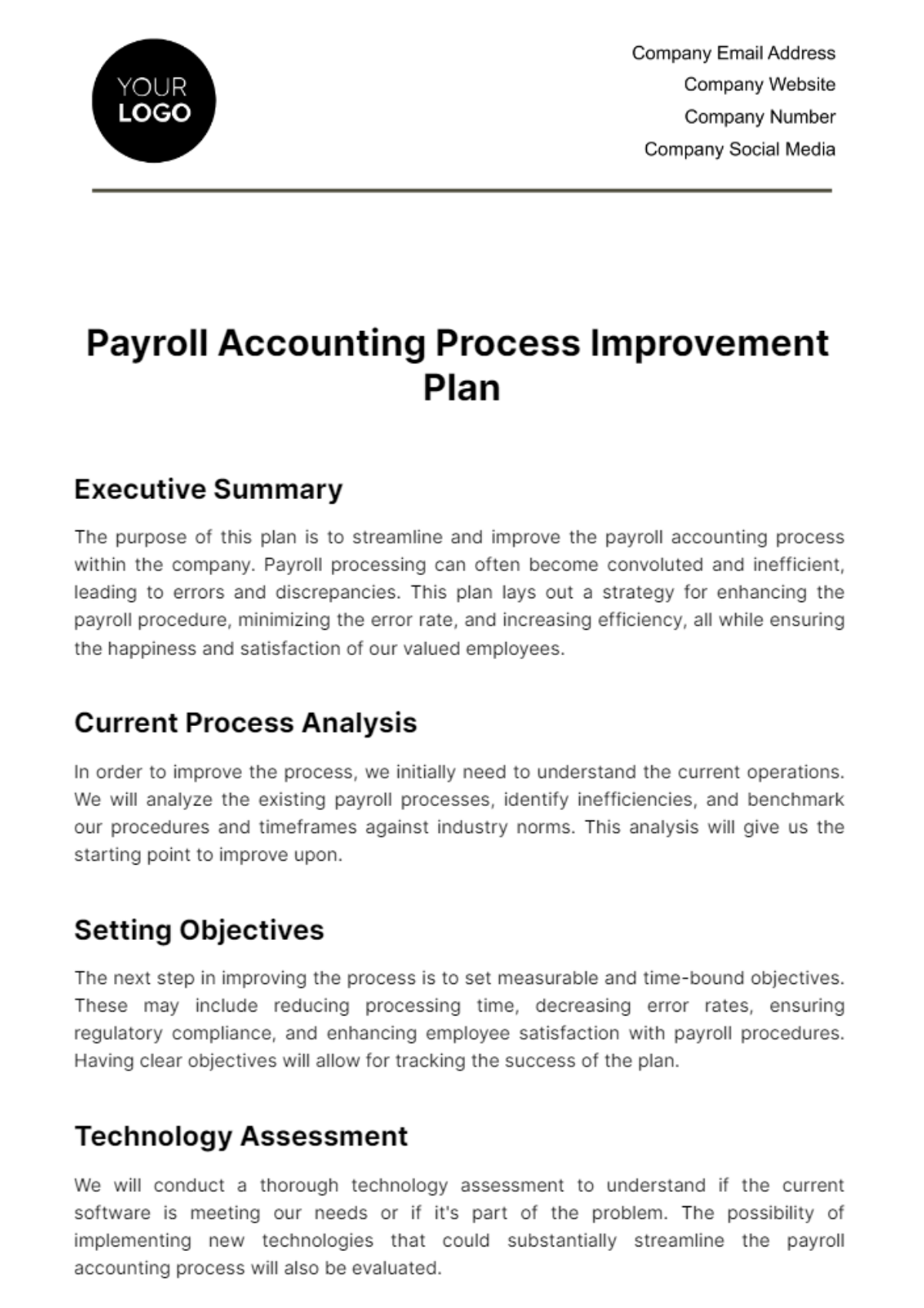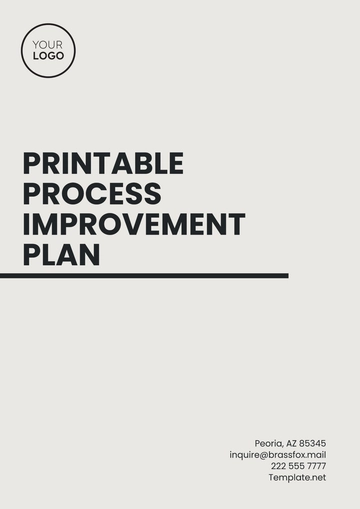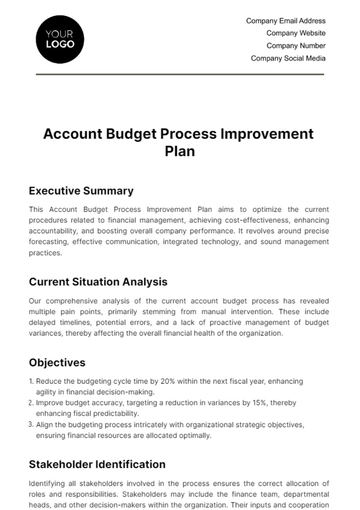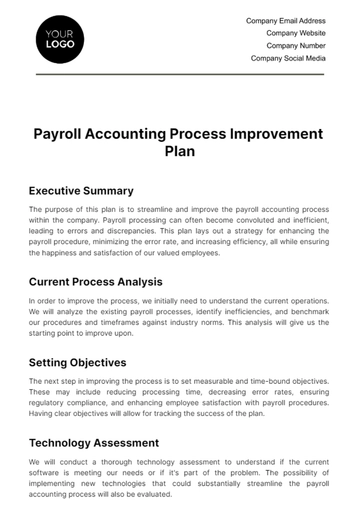Free Payroll Accounting Process Improvement Plan

Executive Summary
The purpose of this plan is to streamline and improve the payroll accounting process within the company. Payroll processing can often become convoluted and inefficient, leading to errors and discrepancies. This plan lays out a strategy for enhancing the payroll procedure, minimizing the error rate, and increasing efficiency, all while ensuring the happiness and satisfaction of our valued employees.
Current Process Analysis
In order to improve the process, we initially need to understand the current operations. We will analyze the existing payroll processes, identify inefficiencies, and benchmark our procedures and timeframes against industry norms. This analysis will give us the starting point to improve upon.
Setting Objectives
The next step in improving the process is to set measurable and time-bound objectives. These may include reducing processing time, decreasing error rates, ensuring regulatory compliance, and enhancing employee satisfaction with payroll procedures. Having clear objectives will allow for tracking the success of the plan.
Technology Assessment
We will conduct a thorough technology assessment to understand if the current software is meeting our needs or if it's part of the problem. The possibility of implementing new technologies that could substantially streamline the payroll accounting process will also be evaluated.
Data Accuracy
Data accuracy is of utmost importance in payroll processing. We should set up protocols to ensure that the data is being entered correctly and consistently. Regular auditing should be in place to verify data accuracy and identify discrepancies immediately.
Process Streamlining
Based on the findings of process analysis and technology assessment, we will focus on streamlining the process. This may involve removing redundant steps, automating manual tasks, or implementing new technologies. The key is to make the process as seamless and efficient as possible.
Training & Development
Any changes implemented, particularly when new technologies are introduced, will require proper training for the staff involved. We should schedule regular training sessions to ensure that all staff understand the new procedures and are comfortable with them.
Policy Review and Revisions
Our payroll policies should be kept up-to-date and should reflect the improved processes. The policies should also suit the current employment laws and regulations. Any changes made should be published and communicated to all the employees in an appropriate and timely manner.
Implementation and Monitoring
After all the planning and preparation, the next step is implementation. It is important to keep an eye open for any obstacles during this phase. Additionally, the effectiveness needs to be monitored regularly to ensure that the plan objectives are being met.
Sustainability & Scalability
This section emphasizes the need for the improvements to be not only effective but also sustainable and scalable. As the organization grows, the improved payroll processes should adapt and grow accordingly to remain efficient.
Conclusion
The Payroll Accounting Process Improvement Plan is a comprehensive strategy aimed at enhancing the efficiency and accuracy of our payroll procedures while ensuring employee satisfaction. By analyzing our current processes, setting clear objectives, assessing technology, prioritizing data accuracy, streamlining operations, and investing in training and policy revisions, we are on track to revolutionize our payroll system.
The implementation phase will be critical, and we will vigilantly monitor progress to ensure that our objectives are met. Furthermore, our commitment to sustainability and scalability ensures that these improvements will serve us well as our organization continues to grow. Our dedication to excellence in payroll processing reflects our commitment to both our employees and the overall success of the company.
- 100% Customizable, free editor
- Access 1 Million+ Templates, photo’s & graphics
- Download or share as a template
- Click and replace photos, graphics, text, backgrounds
- Resize, crop, AI write & more
- Access advanced editor
Template.net offers the Payroll Accounting Process Improvement Plan Template, a versatile solution for businesses. This template, editable with our AI editor tool, streamlines payroll procedures. Customize it effortlessly to meet your unique needs. Boost efficiency and accuracy in managing payroll with this powerful resource, available exclusively at Template.net. Revolutionize your payroll processes today!
You may also like
- Finance Plan
- Construction Plan
- Sales Plan
- Development Plan
- Career Plan
- Budget Plan
- HR Plan
- Education Plan
- Transition Plan
- Work Plan
- Training Plan
- Communication Plan
- Operation Plan
- Health And Safety Plan
- Strategy Plan
- Professional Development Plan
- Advertising Plan
- Risk Management Plan
- Restaurant Plan
- School Plan
- Nursing Home Patient Care Plan
- Nursing Care Plan
- Plan Event
- Startup Plan
- Social Media Plan
- Staffing Plan
- Annual Plan
- Content Plan
- Payment Plan
- Implementation Plan
- Hotel Plan
- Workout Plan
- Accounting Plan
- Campaign Plan
- Essay Plan
- 30 60 90 Day Plan
- Research Plan
- Recruitment Plan
- 90 Day Plan
- Quarterly Plan
- Emergency Plan
- 5 Year Plan
- Gym Plan
- Personal Plan
- IT and Software Plan
- Treatment Plan
- Real Estate Plan
- Law Firm Plan
- Healthcare Plan
- Improvement Plan
- Media Plan
- 5 Year Business Plan
- Learning Plan
- Marketing Campaign Plan
- Travel Agency Plan
- Cleaning Services Plan
- Interior Design Plan
- Performance Plan
- PR Plan
- Birth Plan
- Life Plan
- SEO Plan
- Disaster Recovery Plan
- Continuity Plan
- Launch Plan
- Legal Plan
- Behavior Plan
- Performance Improvement Plan
- Salon Plan
- Security Plan
- Security Management Plan
- Employee Development Plan
- Quality Plan
- Service Improvement Plan
- Growth Plan
- Incident Response Plan
- Basketball Plan
- Emergency Action Plan
- Product Launch Plan
- Spa Plan
- Employee Training Plan
- Data Analysis Plan
- Employee Action Plan
- Territory Plan
- Audit Plan
- Classroom Plan
- Activity Plan
- Parenting Plan
- Care Plan
- Project Execution Plan
- Exercise Plan
- Internship Plan
- Software Development Plan
- Continuous Improvement Plan
- Leave Plan
- 90 Day Sales Plan
- Advertising Agency Plan
- Employee Transition Plan
- Smart Action Plan
- Workplace Safety Plan
- Behavior Change Plan
- Contingency Plan
- Continuity of Operations Plan
- Health Plan
- Quality Control Plan
- Self Plan
- Sports Development Plan
- Change Management Plan
- Ecommerce Plan
- Personal Financial Plan
- Process Improvement Plan
- 30-60-90 Day Sales Plan
- Crisis Management Plan
- Engagement Plan
- Execution Plan
- Pandemic Plan
- Quality Assurance Plan
- Service Continuity Plan
- Agile Project Plan
- Fundraising Plan
- Job Transition Plan
- Asset Maintenance Plan
- Maintenance Plan
- Software Test Plan
- Staff Training and Development Plan
- 3 Year Plan
- Brand Activation Plan
- Release Plan
- Resource Plan
- Risk Mitigation Plan
- Teacher Plan
- 30 60 90 Day Plan for New Manager
- Food Safety Plan
- Food Truck Plan
- Hiring Plan
- Quality Management Plan
- Wellness Plan
- Behavior Intervention Plan
- Bonus Plan
- Investment Plan
- Maternity Leave Plan
- Pandemic Response Plan
- Succession Planning
- Coaching Plan
- Configuration Management Plan
- Remote Work Plan
- Self Care Plan
- Teaching Plan
- 100-Day Plan
- HACCP Plan
- Student Plan
- Sustainability Plan
- 30 60 90 Day Plan for Interview
- Access Plan
- Site Specific Safety Plan


